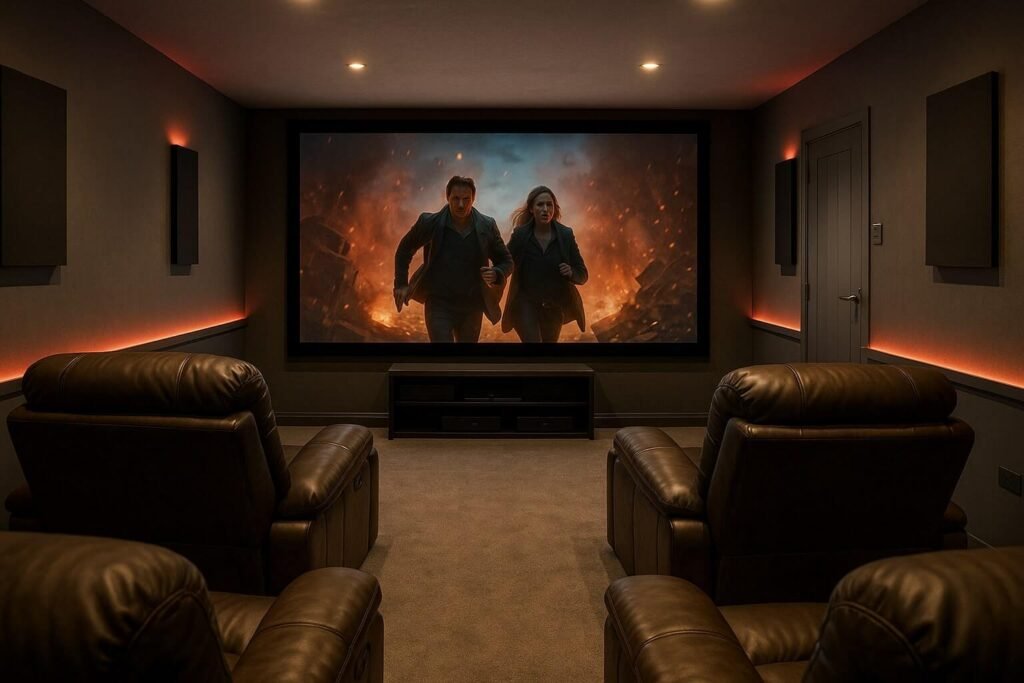Turning your unused garage into a fully-fledged home cinema isn’t just a fun idea, it’s a game-changer. Whether you’re craving immersive Dolby sound, a proper blackout space for late-night films, or simply want to make better use of dead space on your property, the choice to convert garage into a home cinema is smarter than ever. It’s the kind of upgrade that doesn’t just boost your home’s value, it upgrades your lifestyle too.
At TopGarageConversions, we’ve seen garages transformed into everything from barbershops to yoga studios, but there’s something undeniably satisfying about converting one into a movie room. Garages, especially the attached single types, naturally lend themselves to cinema use: they’re dark, detached from main living spaces, and structurally simple to insulate and soundproof. With the right approach, even the most basic shell can be reborn as an acoustically-treated, visually stunning cinema space.
Planning the Perfect Cinema Layout
It starts with measuring your space and thinking through your goals. Most single garages are around 2.4 m wide and 5–6 m long, just enough for two rows of seating and a 100-inch screen. Sight lines are important, so if you’re thinking about a back row, you’ll need a small riser platform – nothing too complex, usually a timber frame stuffed with insulation and topped with chipboard and carpet. Recliners need space behind them, so factor in about 1 m clearance for footrests and walkways.
Then comes projector placement. Most short-throw models only need around 2 m from lens to screen, while others need up to 3.5 m. Make sure the throw distance suits your chosen projector before you fix anything in place. Projectors should be mounted away from the back wall to allow ventilation, and soffit boxes lined with foam help muffle fan noise.
The golden rule is balance. You don’t need the fanciest kit, but you do need kit that works well together. A mid-range 4K projector, a 5.1 or 7.1 surround setup, and a good AV receiver go a long way. Combine that with blackout blinds, dense curtains or acoustic wall panels, and you’ll be halfway to a commercial-grade feel.
Insulation, Soundproofing and Building Regs
Before the carpet rolls out and the popcorn machine goes in, you’ve got to handle the structural groundwork. To convert garage into a home cinema legally and comfortably, you’ll need to meet UK Building Regulations for thermal insulation, fire safety, and ventilation. It’s not difficult, just methodical.
The floor needs insulation – typically 100 mm PIR boards with a DPM underneath to block damp. On the walls, we usually go for timber studs set 50 mm off the brick, filled with dense mineral wool, then double-layer acoustic plasterboard. This not only keeps in the warmth, it deadens outside noise and stops your cinema from disturbing the neighbours. If your garage door is staying, we build a false wall in front of it, filled with insulation and boarded over, keeping a small air gap between to prevent vibration transfer.
Ventilation is another key detail. Even in a sealed cinema room, you need airflow. Passive trickle vents and a quiet in-line extractor usually do the job, meeting Part F requirements without blowing a gale mid-movie.
Lighting should feel considered too. Think soft perimeter LED strips, step lights along your riser if you’ve got one, and blackout switches so you can control the mood instantly. Everything you install, from sockets to lights, should be run off a properly rated circuit, ideally on an RCBO for protection and cleaner AV power.
Time, Cost and The Real Value
A typical single garage conversion into a cinema takes 8–10 weeks start to finish. Strip-out and prep take one, insulation and first fix electrics two or three, then it’s boarding, finishing, kit install and that all-important sound tuning.
As for cost? To convert garage into a home cinema, most homeowners spend between £12,000 and £25,000 depending on how tech-heavy they go. If you want cinema seating, integrated lighting, full acoustic walling, and a top-spec 4K projector setup, you’re looking at the upper end. But many successful conversions land around the £15,000–18,000 mark, including building work.
The payoff isn’t just in resale value, though estate agents say a well-finished home cinema can return 70–80% of your spend when done right. The real reward is having a dedicated space where the family gathers for weekend films, or mates drop in for a football final in surround sound. You’re not just adding square footage, you’re adding an experience.
If your garage is gathering dust, perhaps it’s time to close the curtains, dim the lights, and let the trailers roll.


